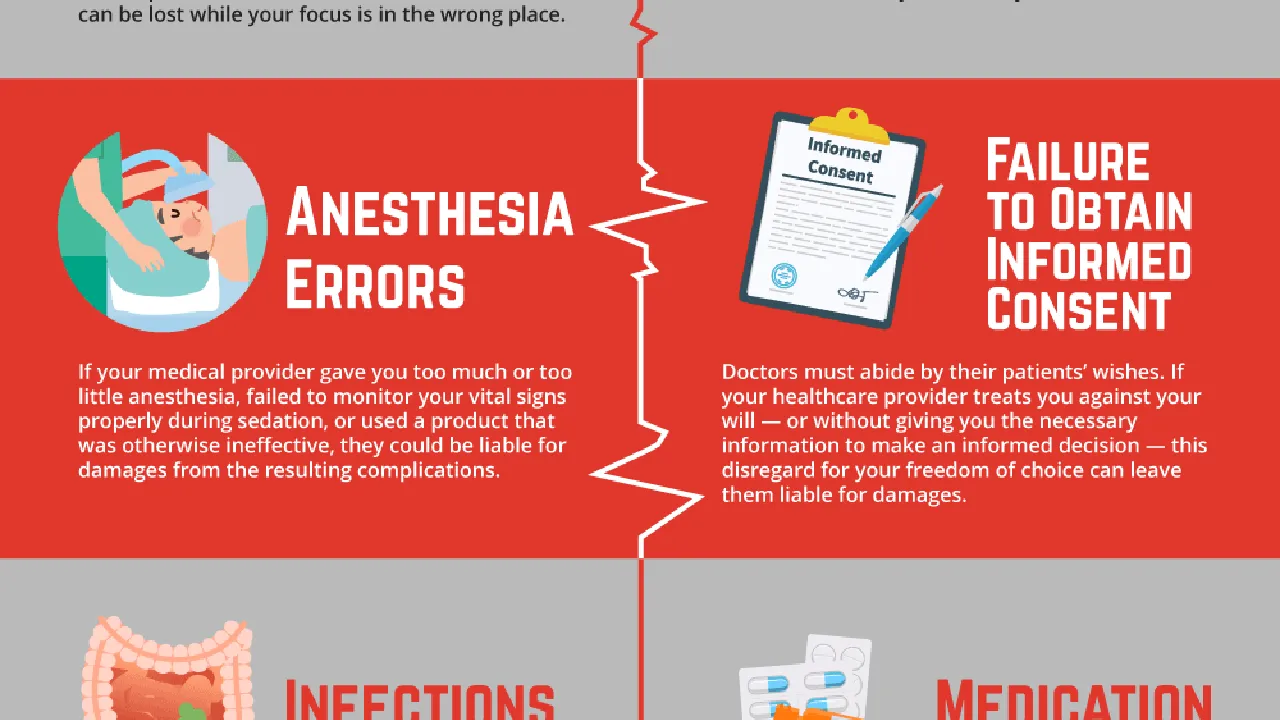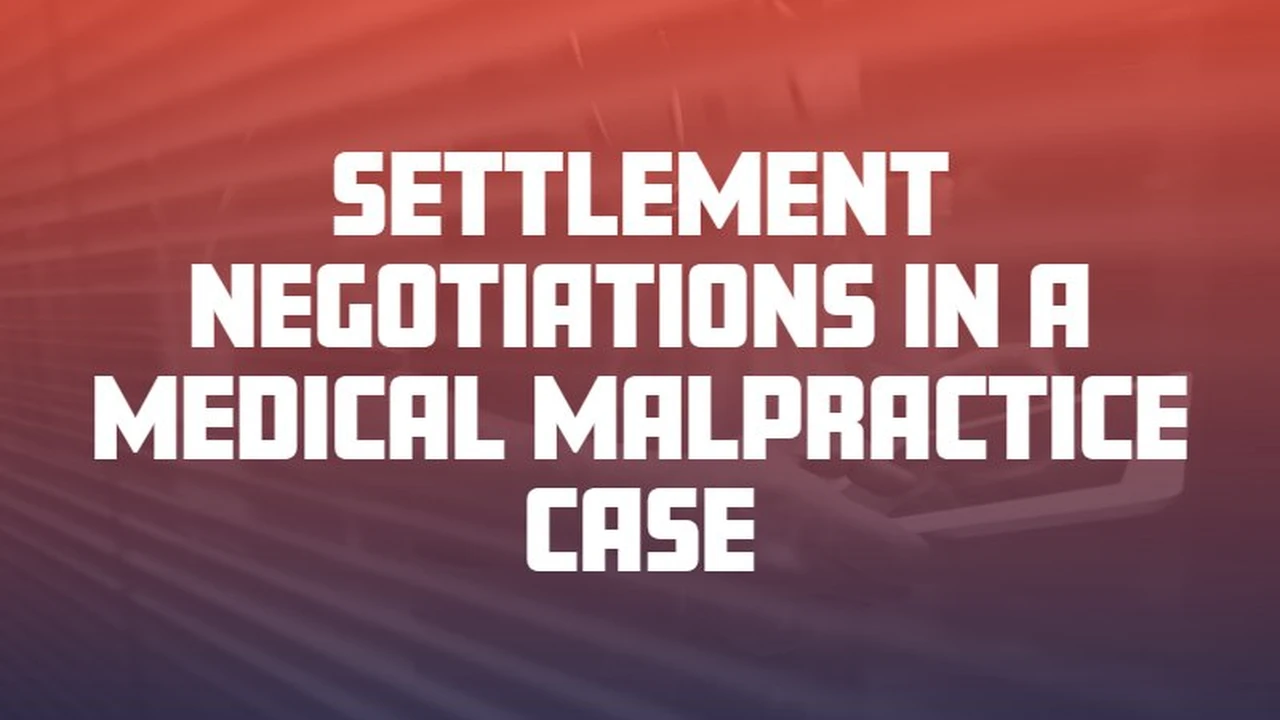5 Signs of Potential Medical Malpractice
Identify the top 5 indicators that you may have been a victim of medical malpractice.

Identify the top 5 indicators that you may have been a victim of medical malpractice. Navigating the healthcare system can be complex, and while most medical professionals provide excellent care, mistakes can happen. When these mistakes lead to harm, it might be medical malpractice. Knowing the signs can help you understand if you have a case and when to seek legal advice. This guide will walk you through five key indicators, offering insights into what to look for and how to proceed.
5 Signs of Potential Medical Malpractice
Understanding Medical Malpractice What It Means for You
Before diving into the signs, let's quickly clarify what medical malpractice is. It's essentially professional negligence by act or omission by a healthcare provider in which the treatment provided falls below the accepted standard of practice in the medical community and causes injury or death to the patient, with most cases involving medical error. The standard of care is what a reasonably prudent healthcare professional would have done under similar circumstances. If a doctor, nurse, hospital, or other medical professional deviates from this standard and you suffer harm as a direct result, you might have a medical malpractice claim.
Sign 1 Unexpected Worsening Condition or New Injury After Treatment
One of the most immediate and alarming signs that something might be wrong is an unexpected worsening of your condition or the development of a new injury after receiving medical treatment. You sought medical help to get better, not worse. While some complications are known risks of any procedure or treatment, a significant and unforeseen decline in health or a completely new problem can be a red flag.
When to Be Concerned About Worsening Conditions
- Post-Surgical Complications: Did you develop an infection that wasn't properly managed? Did a surgical instrument get left inside you? Did you experience nerve damage that wasn't a known risk?
- Medication Errors: Were you given the wrong medication, the wrong dosage, or did your doctor fail to check for dangerous drug interactions, leading to severe side effects or a new illness?
- Delayed Diagnosis: Was a serious condition missed or misdiagnosed, allowing it to progress to a more severe stage that could have been prevented with timely intervention? For example, if a doctor dismisses your symptoms as minor, only for you to later discover you have a rapidly progressing cancer.
- New Symptoms: Did you develop symptoms completely unrelated to your original condition after treatment, such as paralysis after a spinal injection or organ damage after a routine procedure?
It's crucial to differentiate between expected side effects or complications (which your doctor should have discussed with you as part of informed consent) and those that arise from a clear deviation from the standard of care. If your doctor downplays your new or worsening symptoms without adequate explanation or investigation, that's another reason to be concerned.
Sign 2 A Diagnosis That Comes Too Late or Is Incorrect
Timely and accurate diagnosis is paramount in medicine. A delayed or incorrect diagnosis can have devastating consequences, allowing diseases to progress, making treatment more difficult, or even leading to unnecessary and harmful treatments. This is a very common area for medical malpractice claims.
Key Indicators of Diagnostic Malpractice
- Missed Diagnosis: Your doctor failed to diagnose a serious condition despite clear symptoms or test results that should have indicated its presence. For instance, if a radiologist misses a tumor on an X-ray or MRI that another competent radiologist would have identified.
- Delayed Diagnosis: The diagnosis was eventually made, but only after a significant delay that negatively impacted your prognosis or treatment options. This often happens with cancers, heart conditions, or neurological disorders where early intervention is critical.
- Misdiagnosis: You were diagnosed with the wrong condition, leading to inappropriate treatment that either harmed you or prevented you from receiving the correct treatment for your actual illness. Imagine being treated for anxiety when you actually have a thyroid condition, or for a pulled muscle when it's a fractured bone.
- Failure to Order Appropriate Tests: Your doctor failed to order necessary diagnostic tests (like blood work, imaging, or biopsies) that would have led to a correct and timely diagnosis.
- Failure to Act on Test Results: Test results indicating a serious condition were available, but your doctor or their staff failed to review them, communicate them to you, or act upon them in a timely manner.
If you sought a second opinion and that second opinion revealed a completely different and more serious diagnosis that should have been caught earlier, this is a strong indicator of potential malpractice. Always trust your gut feeling if you feel something is being missed or dismissed.
Sign 3 Lack of Informed Consent or Explanation of Risks
Informed consent is a fundamental principle in medical ethics and law. It means that before any medical procedure, treatment, or even significant diagnostic test, your doctor must explain the procedure, its benefits, its risks, and any alternative treatments, allowing you to make an educated decision. If you weren't properly informed, and then suffered a complication that wasn't disclosed, it could be a sign of malpractice.
What Constitutes a Lack of Informed Consent?
- Failure to Disclose Major Risks: Your doctor did not inform you of significant and known risks associated with a procedure or medication, and you suffered one of those undisclosed risks.
- Misrepresentation of Benefits: The doctor exaggerated the benefits of a treatment or downplayed its potential dangers.
- Failure to Discuss Alternatives: You were not informed about other reasonable treatment options, including the option of doing nothing.
- Coercion or Pressure: You felt pressured into a decision without adequate time to consider your options or ask questions.
- Lack of Understanding: The information was presented in a way you couldn't understand, and your questions weren't adequately answered.
It's important to note that informed consent doesn't mean you have to be told every single minor risk, but rather the material risks that a reasonable patient would want to know before making a decision. If you underwent a procedure and then experienced a severe complication that you were never warned about, and that warning would have changed your decision, you might have a case.
Sign 4 Unexplained Injuries During or After a Medical Procedure
Sometimes, injuries occur during a medical procedure that are not a known or expected complication. These can range from surgical errors to injuries sustained during childbirth or even during routine examinations. If you wake up from surgery with an injury unrelated to the surgical site, or if a loved one suffers an injury in a hospital setting without a clear explanation, it's a serious concern.
Examples of Unexplained Injuries
- Surgical Errors: A surgeon operates on the wrong body part, leaves a foreign object (like a sponge or instrument) inside the patient, or damages an organ not involved in the surgery.
- Anesthesia Errors: Injuries due to improper administration of anesthesia, such as brain damage from oxygen deprivation or nerve damage.
- Birth Injuries: Injuries to the baby or mother during delivery that could have been prevented with proper medical care, such as cerebral palsy due to oxygen deprivation or shoulder dystocia from improper delivery techniques.
- Falls in Hospitals: If a patient falls and sustains an injury due to inadequate supervision, lack of bed rails, or failure to assess fall risk, especially if they are elderly or sedated.
- Pressure Ulcers (Bedsores): Developing severe bedsores in a hospital or nursing home can indicate neglect, especially if the patient was immobile and not regularly turned.
In these situations, the injury itself often speaks volumes. If the injury is something that simply shouldn't happen if the standard of care is met, it's a strong indicator of potential malpractice. Don't hesitate to ask for a full explanation and detailed medical records if you suspect such an injury.
Sign 5 A Doctor or Hospital Staff Member Admits a Mistake
While rare, sometimes a healthcare provider or a member of the hospital staff might directly or indirectly admit that a mistake was made. This can be a very clear and compelling sign of medical malpractice. However, it's important to distinguish between an admission of a mistake and simply acknowledging an unfortunate outcome or complication.
What to Look For in Admissions of Error
- Direct Apology and Admission: A doctor explicitly states, "I made a mistake," or "We messed up."
- Indirect Admissions: A doctor might say something like, "This shouldn't have happened," or "I'm not sure why this occurred, it's very unusual," especially if followed by immediate corrective action or a sudden change in treatment plan without clear explanation.
- Changes in Treatment Without Explanation: If your treatment plan suddenly changes drastically, or you are moved to a different unit or assigned a new doctor without a clear medical reason, it could be an attempt to correct a previous error.
- Unusual Documentation: If you notice medical records being altered, missing, or containing inconsistent information, it could be an attempt to cover up a mistake.
- Internal Investigations: If the hospital initiates an internal investigation into your care without a clear reason, it might indicate they suspect an error occurred.
If you hear or observe anything that sounds like an admission of error, try to document it immediately. Note the date, time, who said it, and exactly what was said. This information can be incredibly valuable in a potential medical malpractice claim.
What to Do If You Suspect Medical Malpractice Your Next Steps
If you recognize any of these signs, it's natural to feel overwhelmed, angry, or confused. Here's a general guide on what steps you can take:
1. Gather Your Medical Records
This is perhaps the most crucial step. Request all your medical records related to the treatment in question. This includes doctor's notes, hospital charts, test results, imaging reports, medication lists, and billing statements. You have a legal right to these records. Be thorough and ensure you get everything.
2. Document Everything
Keep a detailed journal of your experience. Note down dates, times, who you spoke to, what was said, your symptoms, treatments received, and how your condition has progressed. Take photos of any visible injuries. The more detailed your personal records, the better.
3. Seek a Second Medical Opinion
Consult with another independent medical professional to get their assessment of your condition and the care you received. They can provide an objective view and help determine if the standard of care was met.
4. Consult with a Medical Malpractice Attorney
This is perhaps the most important step if you truly suspect malpractice. Medical malpractice law is incredibly complex, and you'll need an experienced attorney to evaluate your case. They can review your medical records, consult with medical experts, and determine if you have a viable claim. Most medical malpractice attorneys offer free initial consultations.
5. Be Aware of Statute of Limitations
There are strict deadlines, known as statutes of limitations, for filing medical malpractice lawsuits. These vary significantly by state in the USA and by country in Southeast Asia. If you miss this deadline, you lose your right to file a claim, regardless of how strong your case is. An attorney can advise you on the specific deadlines applicable to your situation.
Comparing Medical Malpractice Laws USA vs Southeast Asia
It's important to understand that medical malpractice laws and the legal landscape differ significantly between the USA and Southeast Asian countries. This impacts how claims are pursued, the types of compensation available, and the overall success rate.
United States
- Litigious Environment: The USA generally has a more litigious environment, and medical malpractice lawsuits are relatively common.
- High Damages: Juries can award substantial damages, including economic damages (medical bills, lost wages) and non-economic damages (pain and suffering, emotional distress). Some states have caps on non-economic damages.
- Expert Testimony: Expert medical testimony is almost always required to prove the standard of care was breached and that the breach caused the injury.
- Discovery Process: The discovery process is extensive, involving depositions, interrogatories, and document production.
- Contingency Fees: Most medical malpractice attorneys work on a contingency fee basis, meaning they only get paid if you win your case.
- Statute of Limitations: Varies by state, typically 1-3 years from the date of injury or discovery of injury, with some exceptions for minors or foreign object cases.
Southeast Asia (General Overview, Varies by Country)
- Less Litigious: Generally, countries in Southeast Asia have a less litigious culture regarding medical malpractice. Patients are often more hesitant to sue doctors.
- Lower Damages: Compensation awards tend to be significantly lower than in the USA, often focusing more on actual economic losses rather than pain and suffering.
- Mediation/Arbitration: There's often a greater emphasis on mediation, arbitration, or government-led compensation schemes rather than full-blown court trials.
- Proof of Negligence: Proving negligence can be challenging, and access to medical records might be more restricted in some countries.
- Legal Costs: Legal costs can be a barrier, and contingency fees are not as common or regulated as in the USA.
- Statute of Limitations: Varies, but generally shorter than in the USA, often 1-2 years.
If you are in Southeast Asia and suspect medical malpractice, it's even more critical to seek legal advice from a local attorney specializing in medical law, as the process and potential outcomes will be very different from what you might expect in the USA.
Specific Products and Services for Medical Malpractice Cases
While there aren't 'products' in the traditional sense that you'd buy to prevent or resolve medical malpractice, there are services and tools that are invaluable for building a case. Think of these as essential resources rather than consumer goods.
1. Medical Record Review Services
- Description: These services employ experienced medical professionals (doctors, nurses) who specialize in reviewing complex medical records to identify deviations from the standard of care, causation, and damages. They can create chronologies, summaries, and identify missing records.
- Usage: Attorneys often use these services early in a case to screen for merit before investing heavily in expert witnesses. They help translate medical jargon into understandable legal arguments.
- Comparison:
- "MedMal Review Pro": Known for rapid turnaround and highly detailed reports, often used for initial case screening. Price: ~$1,500 - $3,000 per case.
- "Physician Legal Consultants": Offers physician-led reviews across various specialties, providing deeper clinical insights. More expensive but highly thorough. Price: ~$3,000 - $7,000+ per case.
- In-house Legal Nurse Consultants: Many larger law firms have these on staff, offering continuous review and support throughout the litigation process. Cost is absorbed into firm overhead.
- Consideration: Essential for understanding the medical facts of your case.
2. Expert Witness Locating Services
- Description: These services connect attorneys with qualified medical experts (doctors, surgeons, specialists) who can provide testimony on the standard of care, causation, and damages. They ensure the expert has the right credentials and experience.
- Usage: Crucial for proving a medical malpractice case. An expert witness will review records, form an opinion, and testify in court or through deposition.
- Comparison:
- "SEAK, Inc.": A well-known and respected service with a vast database of experts across all medical specialties. Offers training for experts as well. Price: Referral fees vary, expert fees are hourly ($400-$1,000+ per hour).
- "TASA Group": Another large expert witness referral service, offering a wide range of experts and often assisting with vetting. Price: Similar to SEAK.
- Direct Referrals: Attorneys often rely on their network of contacts for expert referrals, which can sometimes be more cost-effective or lead to highly specialized experts.
- Consideration: Absolutely necessary for almost all medical malpractice cases.
3. Litigation Support Software
- Description: Software designed to manage and organize the massive amounts of documents (medical records, depositions, exhibits) involved in complex litigation. Features include document review, annotation, and search capabilities.
- Usage: Helps legal teams efficiently manage case files, identify key documents, and prepare for trial.
- Comparison:
- "Relativity": Industry-standard e-discovery and document review platform, powerful but complex and expensive. Used by large firms. Price: Subscription-based, can be thousands per month.
- "CaseFleet": Cloud-based case management and timeline software, more accessible for smaller firms, focuses on building narratives and chronologies. Price: ~$100-$500 per user per month.
- "TrialDirector": Specifically designed for presenting evidence in court, helping to organize and display documents, videos, and images effectively. Price: One-time license ~$1,500-$3,000.
- Consideration: Primarily for the legal team, but contributes to the efficiency and strength of your case.
4. Medical Illustration and Animation Services
- Description: These services create visual aids (illustrations, 3D animations) to explain complex medical concepts, injuries, and procedures to a jury or judge in an understandable way.
- Usage: Powerful tools for demonstrating how an injury occurred, the extent of damage, or how a procedure should have been performed versus how it was actually done.
- Comparison:
- "MediVisuals": A leading provider of medical illustrations and animations, known for high quality and accuracy. Price: Highly variable, from ~$1,000 for a simple illustration to $10,000+ for complex animations.
- "Illustrative Evidence": Offers similar services, often with a focus on anatomical accuracy and clear visual storytelling. Price: Similar to MediVisuals.
- Consideration: Used in more complex or high-stakes cases to enhance jury understanding.
5. Legal Research Databases
- Description: Online platforms providing access to vast libraries of legal cases, statutes, regulations, and secondary sources.
- Usage: Attorneys use these to research precedents, understand specific laws, and build legal arguments relevant to medical malpractice.
- Comparison:
- "Westlaw": One of the two dominant legal research platforms, known for its comprehensive coverage and advanced search capabilities. Price: Subscription-based, often thousands per month for law firms.
- "LexisNexis": The other dominant platform, offering similar features and content. Price: Similar to Westlaw.
- "Fastcase": A more affordable alternative, often included with bar association memberships, offering good coverage for many needs. Price: ~$100-$200 per month or included with membership.
- Consideration: An essential tool for any legal professional, directly impacting the quality of legal arguments in your case.
Remember, these services are typically engaged by your attorney, not directly by you. The costs associated with them are often advanced by the law firm and then reimbursed from any settlement or judgment you receive. This is why choosing the right medical malpractice attorney is so critical – they will have access to these resources and the expertise to utilize them effectively.
If you suspect medical malpractice, don't delay. The sooner you act, the better your chances of understanding what happened and pursuing justice if a mistake was made. Your health and well-being are paramount, and you deserve answers and accountability.
:max_bytes(150000):strip_icc()/277019-baked-pork-chops-with-cream-of-mushroom-soup-DDMFS-beauty-4x3-BG-7505-5762b731cf30447d9cbbbbbf387beafa.jpg)





